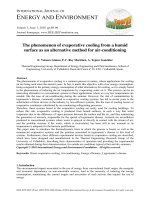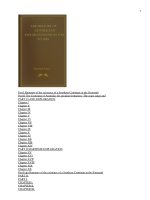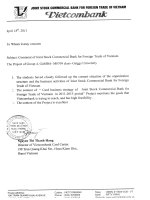end of course essay forex maket topic an analysis of usdjpy fluctuation from 2011 to 2021, as well as solutions for reducing the value on
Bạn đang xem bản rút gọn của tài liệu. Xem và tải ngay bản đầy đủ của tài liệu tại đây (468.14 KB, 19 trang )
UNIVERSITY OF UEH
BUSINESS SCHOOL
BANKING DEPARTMENT
--- ---
End-of-course essay
Forex Maket
Topic:
AN
ANALYSIS
OF
USD/JPY
FLUCTUATION FROM 2011 TO 2021, AS WELL
AS SOLUTIONS FOR REDUCING THE VALUE ON
Class code:
Lecturer:
Name:
Batch: K45/DHCQ
Class: NHC01
Ho Chi Minh City, November 2021
download by :
Contents
I. INTRODUCTION....................................................................................................................... 1
II.
ANALYSIS OF THE USD/JPY VALUE FROM 2011 TO 2021...................1
2.1.
A synopsis of the USD/JPY currency pair's variables from 2011 to 2021....................... 1
2.2.
Examine the factors that contribute to currency fluctuations............................................. 3
2.2.1.
The monetary and foreign currency policies of the United States and Japan are studied ...4
2.2.2.
Analysis of the influence of interest rate differentials between the Fed and the Bank of Japan
6
2.2.3.
Inflationary pressures in Japan and the United States are explored......................... 9
2.2.4.
Examine how the balance of payments affects you.................................................. 11
III.
EXCHANGE VALUE LIMITATION METHODS................................................. 11
3.1.
Put in place policies to assist the economy thrive while keeping inflation under control...11
3.2.
Reduce the spread between the two countries' interest rates........................................ 12
IV.
CONCLUDE........................................................................................................................... 13
Reference.......................................................................................................................................... 15
download by :
List of Chart
Chart 1. USD/JPY exchange rate movement from 2011 to 2021..........................2
Chart 2. USD/JPY exchange rate movement in 2020 to 2021................................ 3
Chart 3. US/JP 10-year Bond Yield Spread vs. USD/Yen......................................... 8
Chart 5. Asset holding.................................................................................................................... 9
Chart 6. Inflation and employment in Japan 2017 – 2019....................................... 10
download by :
I. INTRODUCTION
According to the World Bank, Japan has the world's third largest economy.
Japan is a big exporter of items to other countries. Because of Japan's
substantial trading with the United States, Asia, Europe, and other countries,
multinational firms must routinely convert local currencies into yen.
Having said that, it is becoming increasingly frequent in trade to sell yen for yen.
The Japanese yen (JPY) is Asia's and the world's most traded currency. JPY
made up over 21.6 percent of daily trading in 2016. There was conjecture in the
1980s that the yen would eventually join the US dollar as a world reserve
currency. The Japanese yen can also be used as a proxy (alternative) for Asian
economic growth because it is Asia's most liquid currency. Investors might buy or
sell the Japanese yen when economic or financial crisis threatens Asia.
However, as the global economy improves and more investors prefer to relocate
their capital to USD or other strong currency alternatives, the JPY tends to
decrease. The pandemic's impact on the global financial sector is now enormous,
producing exchange rate fluctuation. Long-term interest rates have risen as a result
of a strong sell-off in the US Treasury bond market; the Japanese government bond
(JGB) is also under pressure. As a result, I decided to look into the USD/JPY
exchange rate's volatility as well as ways to decrease volatility.
II.
2.1.
ANALYSIS OF THE USD/JPY VALUE FROM 2011 TO 2021
A synopsis of the USD/JPY currency pair's variables from 2011 to 2021
The USD/JPY rate is one of the world's most traded and liquid currency pairs because
the Japanese yen, like the US dollar, is a widely used reserve currency. The bid/ask
spread on the USD/JPY pair is minimal, and the pair has high liquidity. Despite the fact
that the Japanese economy has failed in the twenty-first century, the yen has remained
a safe haven currency that people resort to when market volatility emerges.
download by :
Chart 1. USD/JPY exchange rate movement from 2011 to 2021
Source: Macrotrends
Over the previous decade or so, the USD/JPY pair has experienced numerous price
swings. During the Great Recession of 2008, the USD/JPY pair spent the most of the year
above the 90 mark. The biggest loss was in January 2012, when one dollar was only worth
76 JPY. After bottoming in early 2012, the USD immediately recovered traction, signifying
the start of the pair's long uptrend. In May 2015, the ratio reached a high of 124.
In 2016, when the USD was valued at roughly 100 yen, the next large decrease
happened. Financial markets became disappointed with the Trump administration's
pro-growth policies, causing the fall.
In 2017, the outlook for the USD/JPY shifted as the US economy continued to
report strong results and grow at a rapid pace, boosting the US dollar.
The yen functioned as a safe haven during the trade war's development in 2019, while the
US economy's confidence kept the Greenback strong. The couple has managed to stay
download by :
above the 100-point mark. From late 2019 through October 2021, the coronavirus
outbreak had an impact on all financial markets, including Forex.
Chart 2. USD/JPY exchange rate movement in 2020 to 2021
Source: Macrotrends
The US Federal Reserve decreased interest rates in 2020 in an effort to minimize the
economic impact of the epidemic. The Bank of Japan is also aiming to supply liquidity to
the market in dealing with the effects of the Coronavirus. After the Fed expressed its
thoughts on actual inflation statistics in early 2021, the JPY dropped against the USD. The
JPY declined against the USD given the difference in yields between US and Japanese
government bonds, as well as future inflation forecasts. By the 29th of October, the
USD/JPY had risen to about 114.5 and had bounced off the 100 SMA. Many experts
believe that this currency pair's rate will remain below 100 in 2023, ending at 93.93.
2.2.
Examine the factors that contribute to currency fluctuations
download by :
2.2.1. The monetary and foreign currency policies of the United States and Japan
are studied
Despite the fact that academics disagree on whether central bank interventions are
effective, it is vital to examine their possible influence. The Bank of Japan (BoJ)
takes action in the currency market when yen fluctuations threaten Japan's exports
or economic growth.
In 2006, the Bank of Japan ended its quantitative easing program (increasing the money
supply through open market operations). When the Japanese economy began to recover
and inflation returned in early 2007, the United States went into recession, followed by the
European public debt crisis, and the entire globe went into economic crisis. Japan had
officially entered a recession at this point, and deflation had returned as well. The Bank of
Japan is required to cut interest rates to 0.3 percent, and the Japanese government is
considering another bailout. However, Japan's present recovery was hampered by the
global economic situation at the time, as well as the JPY's appreciation. To address labor
market challenges, the Japanese government proposed a fresh economic stimulus plan
totaling JPY 23 trillion (USD 242 billion) on December 12, 2008. A record budget of 88.5
trillion yen ($980 billion) for the 2009 fiscal year was approved on December 29, 2008.
(starting April 2009). Shinzo Abe, Japan's prime minister, assumed office in December
2012, hoping to rebuild the country's economy. He suggested Abenomics, a "three-arrows"
policy consisting of monetary easing, fiscal consolidation, and economic transformation.
The first arrow has a direct effect on the yen exchange rate.
The Bank of Japan (BoJ) governor, Haruhiko Kuroda, stated in April 2013 that the agency
planned to attain a 2% inflation rate in two years by a qualitative expansion policy (QQME).
The size of the new monetary policy target, the base money, will be increased from 138
trillion yen (end of 2012) to 270 trillion yen, regardless of interest rate movements (end of
2014). As a result of this strategy, the base currency's share of GDP will more than double,
reaching approximately 60% in the future. Until 2007, the global money-base to
download by :
GDP ratio was around 5% to 10%. This shows that the Bank of Japan is experimenting
with new monetary policies. The purchase of Japanese government bonds, particularly
bonds with maturities ranging from 6 to 8 years, was used to boost monetary volume
and have a long-term qualitative effect on interest rates and capital markets.
The Bank of Japan has pursued this policy in order to cut long-term interest rates, which
has benefited real assets while harming the yen's foreign exchange rate. The Bank expects
that by doing so, it will be able to promote overall economic demand while minimizing
deflationary pressures on specific economic units. Greater pricing, higher incomes, more
investment, and more consumer goods purchases will appear at the conclusion of the
chain of impacts. The demand gaps in the overall economy will be filled.
The yen jumped in the fourth quarter of 2016 as the Bank of Japan decided to keep its
monetary policy unaltered, raising the basic money supply by almost 80,000 billion yen
(equal to about 648 billion USD). Despite the fact that exports and output remain weak due
to developing nations' poor development, the bank claims that the Japanese economy
"continues to be on a moderate recovery trend" as a result of the asset purchase program.
A high yen, on the other hand, may hurt corporate profits and stymie the Japanese
government's and Bank of Japan's efforts to bring the country out of a deflationary spiral.
The Bank of Japan made this decision after the US Federal Reserve Bank (FED)
kept interest rates constant on June 15, 2016, citing the possibility of Britain exiting
the European Union (EU), which has caused anxiety. The yen gained more than
1% against the dollar immediately following the Bank of Japan's decision, reaching
a high of 104.53 yen to 1 USD, its highest level since September 2014. The euro
fell against the yen as well, going from 119.17 yen before the monetary policy
decision to 117.84 yen, its lowest level in more than three years.
According to data from the Bank of Japan, the corporate commodity pricing index (CGPI),
which measures the prices corporations charge for goods and services, increased by 5.6
percent in the previous year (BoJ). Compared to the same period last year, July 2021 will
download by :
be greater than the market's ordinary projection of a 5% gain. The index jumped from a 5%
rise in June 2021 to its highest level since September 2008, when it jumped 6.9%. In July
2021, wholesale prices grew 1.1 percent over the previous month, following a 0.6 percent
increase in June 2021, the highest increase since October 2019. Despite evidence of
economic growth, the Bank of Japan has no intention of tightening monetary policy.
After committing not to raise interest rates until at least 2024, the Fed now predicts a rate
hike in 2023 in 2021. The Bank of Japan, on the other hand, decided to keep all monetary
policy measures same, despite a more optimistic assessment of the economy (short-term
interest rate -0.1 percent, long-term interest rate 0 percent). All of this contributes to the
monetary policy management disparity between the US and Japan.
2.2.2. Analysis of the influence of interest rate differentials between the Fed and
the Bank of Japan
Factors affecting the value of the US dollar and the Japanese yen in respect to
each other or to other currencies have an impact on the USD/JPY currency pair. As
a result, the interest rate difference between the Federal Reserve (FED) and the
Bank of Japan (BoJ) has an impact on the two currencies' relative values.
Factors that affect the value of the US dollar and the Japanese yen in respect to each
other or to other currencies have an impact on the USD/JPY currency pair. As a result,
the interest rate differential between the Federal Reserve (FED) and the Bank of Japan
(BoJ) influences the relative value of the two currencies. Because the US dollar is
already higher against the Japanese yen, if the Fed's market intervention leads the US
currency to appreciate, the value of the USD/JPY cross rate will rise.
Despite the fact that the Japanese economy is confronted with severe challenges in the
twenty-first century, the yen remains a safe haven currency. When the market is moving,
investors will rush to the Japanese yen, which will cause it to gain. It traded as high as 120
yen in 2007 and as low as 90 yen in 2009, as the Great Recession revealed. The Japanese
yen, on the other hand, begins to decline when the global economy is booming and the
download by :
stock market is growing. Following the Great Recession, the Japanese yen gradually lost
value against the US dollar as the global economy recovered. When the Bank of Japan
conducted large-scale quantitative easing in 2013, the drop was accelerated. In 2018, the
Japanese yen (JPY) was the main foreign currency that appreciated the most against the
US dollar. Global investors have actively acquired the JPY as a safe haven for assets in the
face of a potentially unpredictable economic, trade, and political situation over the previous
year. Despite the fact that the GBP and Euro are facing several issues as a result of Brexit
and Italy's budget crisis, the JPY has climbed dramatically as a result. Furthermore, the USChina trade war, as well as the significant decline in oil prices, have put pressure on the
currencies of strong exporting countries, such as the Canadian dollar. At the end of 2018,
the JPY had grown by more than 2.5 percent, and the USD/JPY exchange rate had
reached 109.88. Furthermore, in the third quarter of 2018, the JPY's proportion of global
foreign exchange reserves grew to 5%, the highest level in 16 years.
download by :
Chart 3. US/JP 10-year Bond Yield Spread vs. USD/Yen
Source: Macromicro
In 2021, the JPY will fall against the USD due to the yield differential between US and
Japanese government bonds. The link between the USD/JPY rate and the yield spread
on large bonds is illustrated in the graph above. The yield on a 10-year Japanese
government bond (JGB) issued by the US government (UST) has climbed to +0.92 (the
highest is 1), compared to historical data of +0.5 and +0.6 in 2020. This means the
USD/JPY will continue to increase if the UST rises above the JGB.
Chart 4. Japan 10Y Bond Yield (percent)
Source: Tradingeconomics
To help the economy prepare for the future, the Bank of Japan purchased additional assets
worth JPY12 trillion and JPY180 billion, respectively, including government bonds, ETFs,
and REITs (Real Estate Investment Trusts), and some more commercial paper and
corporate bonds with a limit of JPY 7.5 trillion each until the end of March 2021. As of
download by :
November 2020, the Bank of Japan owned 45.1 trillion yen in Japan through a ETF. On
December 8, 2020, the Japanese government passed a package of relief measures called
"Comprehensive Economic Measures to Secure People's Lives and Living Standards
Toward Relief and Hope." The budget agreement is valued at 73.6 trillion yen.
2.2.3. Inflationary pressures in Japan and the United States are explored
The fact that Japan is facing deflation while the US has a booming inflation index is
one factor influencing the USD/JPY pair.
Chart 5. Asset holding
The Bank of Japan's and the Federal Reserve's monetary policies have been diverging
since 2013-14, as shown in Chart 7. The Federal Reserve boosts short-term interest rates,
while the Bank of Japan expands its asset holdings. The Federal Reserve's balance sheet
dropped as a proportion of GDP after ending quantitative easing (QE3) in 2014. The
continuing policy divide emphasizes the economic disparity between the two nations. The
BoJ's wealth accumulation accelerated in 2013, following Shinzo Abe's election as Prime
Minister, in contrast to the Fed's accommodation cuts in 2013-14.
To enhance inflation expectations, the government and the Bank of Japan jointly
announced on January 22, 2013, that the BoJ will commence additional asset purchases
and double its inflation target from 1% to 2%. The Bank of Japan strengthened these steps
in January 2016 by establishing a system of negative deposit rates on some reserves held
download by :
by the central bank. To put it another way, the Bank of Japan said on September 21,
2016, that it will begin targeting the non-centralized overnight rate and the 10-year
forward yield at the same time as part of a program known as "Qualitative and
qualitative easing with Yield Curve Control." In recent history, the practice of major
central banks striving for lengthy yields is unprecedented. The BOJ has mainly
succeeded in this goal, keeping overnight rates between 0% and 0.10 percent and
10-year Japanese government bond yields between -0.1% and 0.10 percent.
Chart 6. Inflation and employment in Japan 2017 –
2019 Source: Statistics Bureau of Japan
The Japanese economy recovered in the third quarter of 2020, attaining a negative growth
rate of 5.7 percent (yoy), a considerable increase from the second quarter, following the
destruction of the second half of 2019, the US-China trade war, and the pandemic
(negative growth of 10.3 percent). Retail and commercial activity, as well as exports, swiftly
download by :
recovered. The industrial production index was 95.2 in November. Inflation declined
considerably again in the third and fourth quarters of 2020.
2.2.4. Examine how the balance of payments affects you.
Japan's reliance on imports and exports is another factor to consider when trading the
yen. Rising commodity prices might hurt the Japanese economy and weaken the yen
because Japan is highly dependent on oil and other natural resource imports. Slower
economic growth in compared to key trading partners could make Japan's economy
increasingly reliant on exports to make up for its lack of resources. As the yen
strengthens, Japan's dependence on exports may compel central bank assistance.
As crude oil prices climbed, traders sold the yen, increasing concerns that Japan's
balance of trade would widen as rising energy prices increased imports and raised
demand for the dollar to buy oil. However, the dollar continues to gain in line with an
increase in long-term bond yields published by the US Treasury Department as a result
of rising fuel prices, creating concerns about the country's inflationary potential.
Investors expect the Fed to start reducing asset purchases as soon as November
2021. The Fed's stance contrasts with the Bank of Japan's (BoJ) lightweight monetary
policy, which is intended to boost economic growth and inflation.
III.
3.1.
EXCHANGE VALUE LIMITATION METHODS
Put in place policies to assist the economy thrive while keeping inflation under
control.
The difference in the inflation rates of the base and quote currencies determines the
volatility of the exchange rate owing to inflation. A country with higher inflation has lower
purchasing power, and its currency will depreciate if it is higher than the global or
regional average. It's standard operating procedure. As a result, the greatest
approaches to lessen the volatility of the USD/JPY currency pair chosen by the Bank of
Japan include economic growth and maintaining an acceptable level of inflation.
download by :
Progress toward the 2% target will be closely examined in the coming months,
given the Bank of Japan's policy framework for maintaining monetary easing. In the
long run, vaccination rates will continue to be a key accelerator for economic
recovery. The economic impact of the COVID-19 epidemic will "decrease" in the
near future, with an estimated 28 percent of the population fully vaccinated in the
United States and Japan. As a result, in order to meet the inflation index's target,
the Bank of Japan must maintain a loose monetary policy. As a result, the BoJ
provided liquidity to the private non-financial sector in addition to supporting liquidity
in the banking sector during this crisis. Furthermore, they are able to give their own
currencies to other countries through currency swaps with other Central Banks.
The Bank of Japan uses a discount window and frequently intervenes to help major
market participants by issuing low-risk bonds as collateral for loans. Long-term
lending strategies are also being widely used to promote credit for individuals and
non-financial organizations.
3.2.
Reduce the spread between the two countries' interest rates.
The fundamental cause of variations in the exchange rate between these two powerful
currencies is the differential in prime interest rates between the United States and
Japan. In fact, short-term money will flow into whichever country has a higher shortterm interest rate to collect the interest differential. As a result, foreign currency supply
will rise, foreign currency demand will fall, and the exchange rate will fall.
In response to an increase in Covid-19 instances, the Bank of Japan (BoJ) forecasts 0.1
percent inflation in fiscal 2021-2022 (down from 0.5 percent), 0.8 percent inflation in fiscal
2022-2023, and just 1% inflation in fiscal 2023-2024. Despite a series of stimulus packages
and loose monetary policy, this new forecast demonstrates that Japan's inflation objective
of 2% is proving increasingly difficult to reach. Short-term policies of the Bank of Japan aim
to boost interest rates to 0.1 percent, or no lower than negative rates. If this is the case,
download by :
the rate of exchange between the BoJ and the Fed isn't considerable when the US
(0.25 percent) and Japan (0-0.1 percent) basic interest rates aren't too far away.
More foreign exchange liquidity measures, in my opinion, should be studied by the
Bank of Japan and the Federal Reserve. These approaches help to reduce market
tensions, minimize costs, and extend the age of swap programs with other central
banks. Allowing countries with USD problems to borrow USD as security in the form
of US Treasuries is a good idea.
Furthermore, policies encouraging Japanese institutions to purchase US bonds can
help to lessen currency volatility. The USD/JPY exchange rate will be kept from falling
sharply thanks to rising liquidity and relatively high interest rates in US bonds.
IV.
CONCLUDE
After the US dollar and the Euro, the Japanese yen is the third most extensively used
currency. Despite considerable demand for practically all commodities, Japan rapidly rose
to the top of the industry's export rankings, led by Sony, Hitachi, Honda, Nissan, and
Toyota. As a result, manufacturing facilities are constantly identified with the Japanese
economy. When paying for goods and services provided by Japanese enterprises, JPY is in
high demand as an exporting country. The yen has become a popular trading currency due
to its continually low interest rates. Japan's central bank was forced to keep interest rates
extraordinarily low as a result of the economic crisis in order to foster economic growth. The
Japanese yen has grown immensely popular in international trade due to its low interest
rates. As a result, the USD/JPY pair is heavily traded on international currency exchange
markets. In today's global financial markets, the yen is still a very important currency.
The acts of the Bank of Japan and the Federal Reserve are now influencing the USD/JPY.
The Federal Reserve of the United States has decreased interest rates this year in an effort
to reduce the economic impact of the outbreak. The Bank of Japan is also aiming to supply
liquidity to the market in order to minimize the effects of the Coronavirus. The study
download by :
studies the USD/JPY volatility from October 2011 to October 2021 and provides
strategies to decrease future relationship between exchange rate.
download by :
Reference
1.
Schrimpf, A, H S Shin and V Sushko (2020): “Leverage and margin
spirals in fixed income markets during the Covid-19 crisis”, BIS Bulletin, no
2.
2.
Bùi Duy Hưng (2020), Chính sách tiền tệ trong bối cảnh Covid-19 ở
một số nước phát triển và Việt Nam, Tạp chí Ngân hàng số 16/2020
3.
Brian Perry. (2010). Popular Forex Currencies. Investopedia.
/>4.
Alberola, E, Y Arslan, G Cheng and R Moessner (2020): “The
differential fiscal response to the coronavirus crisis in advanced and
emerging market economies”, BIS Bulletin, forthcoming.
5.
Christopher J. Neely (2019), The Asset Holdings of the Bank of Japan,
economic research, 2019, no.17
6.
Avdjiev, S, E Eren and P McGuire (2020): “Dollar funding costs during the
Covid-19 crisis through the lens of the FX swap market”, BIS Bulletin, no 1, 1 April.
7.
Christopher J. Neely (2019), The Asset Holdings of the Bank of Japan,
economic research, 2019, no.17
download by :









